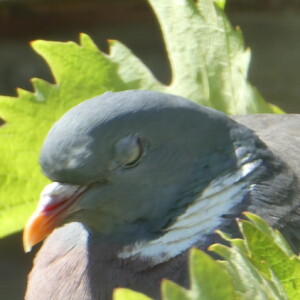Watch the birdie
For an instant, the pigeon oriented its head at exactly the right angle, so that the sun caught the cornea of its eye and gave it the look of having a jewel in its head. Can you see my two hands describing the one that got away?
Momentarily, I thought I'd had a different kind of luck (extra). I thought I had caught it closing its 'third eyelid'. All birds have a transparent 'nictitating membrane' that closes either vertically or diagonally across the eye This performs the same cleaning, lubricating and protective functions as our eyelids, but without obscuring vision. Very handy if you are a peregrine, flying in dirty air at 350kph plus, and don't want to lose your quarry. Equally useful for a gannet under water - built in goggles - or a sparrowhawk grappling with a resistant starling. If humans had one, we could halve the time consumed by taking wedding photos
Closer examination of the far-from-crisp image makes me think it was actually just a not-quite-awake pigeon, half closing its normal upper eyelid. Generally, birds only close them to sleep; generally. Birds that sleep on the wing - and some risk-averse species that roost normally - can close one eye and put half their brain to sleep, then swap over. What a gift
The nictitating membrane contains a duct that releases lubricant as it moves over the eye - the same function as our tear ducts - but it can't produce tears of emotion as we do - as I have several times today (I'm fine, but other people's lives and words stir the emotions). The blood-red tears of the dove of peace, however pertinent, are a work of the imagination


Comments
Sign in or get an account to comment.


